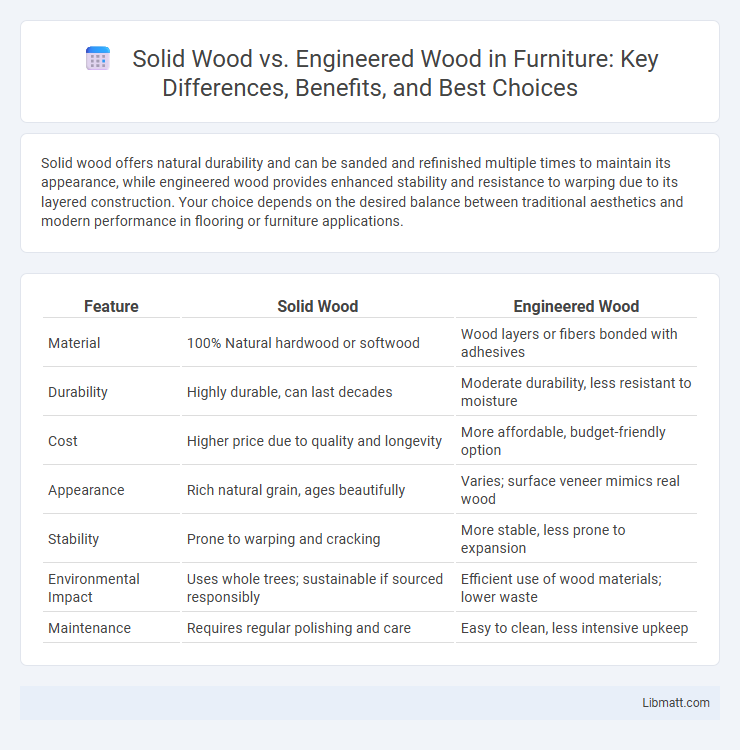Solid wood offers natural durability and can be sanded and refinished multiple times to maintain its appearance, while engineered wood provides enhanced stability and resistance to warping due to its layered construction. Your choice depends on the desired balance between traditional aesthetics and modern performance in flooring or furniture applications.
Table of Comparison
| Feature | Solid Wood | Engineered Wood |
|---|---|---|
| Material | 100% Natural hardwood or softwood | Wood layers or fibers bonded with adhesives |
| Durability | Highly durable, can last decades | Moderate durability, less resistant to moisture |
| Cost | Higher price due to quality and longevity | More affordable, budget-friendly option |
| Appearance | Rich natural grain, ages beautifully | Varies; surface veneer mimics real wood |
| Stability | Prone to warping and cracking | More stable, less prone to expansion |
| Environmental Impact | Uses whole trees; sustainable if sourced responsibly | Efficient use of wood materials; lower waste |
| Maintenance | Requires regular polishing and care | Easy to clean, less intensive upkeep |
Introduction to Solid Wood and Engineered Wood
Solid wood refers to natural timber cut directly from trees, known for its durability, unique grain patterns, and ability to be sanded and refinished multiple times. Engineered wood consists of multiple layers of wood veneers or fibers bonded together, designed to enhance stability and resistance to moisture and warping. Both materials serve diverse purposes in furniture and flooring, with solid wood prized for authenticity and engineered wood favored for cost-effectiveness and structural consistency.
Composition and Manufacturing Process
Solid wood consists of natural timber harvested directly from trees, maintaining its original cellulose fibers with no layering or bonding involved. Engineered wood is manufactured by bonding multiple layers of wood veneers, fibers, or particles with adhesives, creating a product designed for enhanced stability and resistance to warping. Your choice between these materials depends on preferences for natural grain authenticity versus structural consistency and adaptability.
Durability and Lifespan Comparison
Solid wood offers exceptional durability with a lifespan that can exceed 100 years when properly maintained, thanks to its natural density and resistance to wear. Engineered wood features a layered construction that enhances stability and resists warping, yet typically has a shorter lifespan, often lasting 20 to 30 years under normal use. Your choice between these materials should consider the trade-off between the long-term durability of solid wood and the moisture resistance and cost-efficiency of engineered wood.
Aesthetics and Visual Appeal
Solid wood offers a timeless, natural grain and rich texture that enhances the visual warmth and authenticity of furniture and flooring. Engineered wood presents a consistent appearance due to its layered construction, often featuring a top veneer of high-quality hardwood that mimics the look of solid wood. The choice between solid and engineered wood significantly impacts the aesthetic value, with solid wood often preferred for its unique, natural variations and engineered wood favored for its uniformity and resistance to visible wear.
Environmental Impact and Sustainability
Solid wood offers a more sustainable option due to its natural biodegradability and potential for carbon sequestration, with responsibly sourced timber minimizing deforestation risks. Engineered wood maximizes resource efficiency by utilizing wood fibers and veneers from fast-growing or recycled trees, reducing waste and preserving old-growth forests. Lifecycle assessments reveal engineered wood products generally have lower carbon footprints and energy consumption, contributing positively to environmental impact compared to traditional solid wood.
Cost Differences and Budget Considerations
Solid wood typically incurs higher upfront costs due to its natural composition and durability, making it a premium choice for long-term investment. Engineered wood offers a more budget-friendly alternative with comparable aesthetics, using layered construction to reduce material expenses while maintaining structural integrity. Budget considerations should factor in installation complexity and potential maintenance costs, where engineered wood often provides economic benefits without sacrificing quality.
Installation Methods and Ease
Solid wood requires traditional nailing or screwing during installation, often demanding experienced labor due to its sensitivity to moisture and expansion. Engineered wood offers multiple installation options such as click-lock, glue-down, or floating systems, making it more versatile and easier for DIY projects. Your choice impacts not only the ease of installation but also the time and tools needed for a successful flooring upgrade.
Maintenance and Care Requirements
Solid wood requires regular polishing and protection from moisture and temperature fluctuations to prevent warping and cracking. Engineered wood demands less maintenance due to its multi-layer construction, showing greater resistance to humidity and temperature changes. Both materials benefit from prompt cleaning of spills and the use of protective pads to avoid surface damage.
Suitability for Different Environments
Solid wood offers excellent durability and natural insulation, making it ideal for dry, stable environments where temperature and humidity changes are minimal. Engineered wood, constructed from layered materials, provides superior resistance to moisture and warping, making it more suitable for areas with fluctuating humidity or basements. Choosing the right option depends on your environment's conditions and how much exposure to moisture and temperature variation your flooring or furniture will face.
Pros and Cons Summary: Solid Wood vs Engineered Wood
Solid wood offers durability and natural beauty with the ability to be refinished multiple times, but it can be prone to warping and is often more expensive. Engineered wood provides enhanced stability and resistance to humidity due to its layered construction, making it a cost-effective option, although it typically has a limited lifespan and cannot be sanded as extensively. Your choice depends on prioritizing longevity and appearance versus budget and environmental conditions.
Solid Wood vs Engineered Wood Infographic

 libmatt.com
libmatt.com